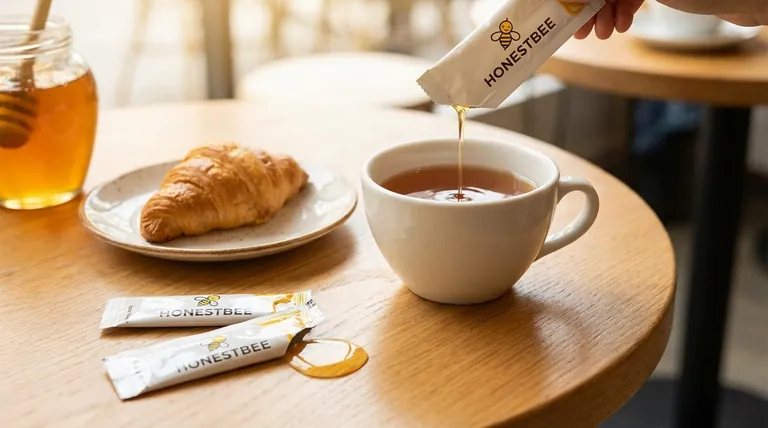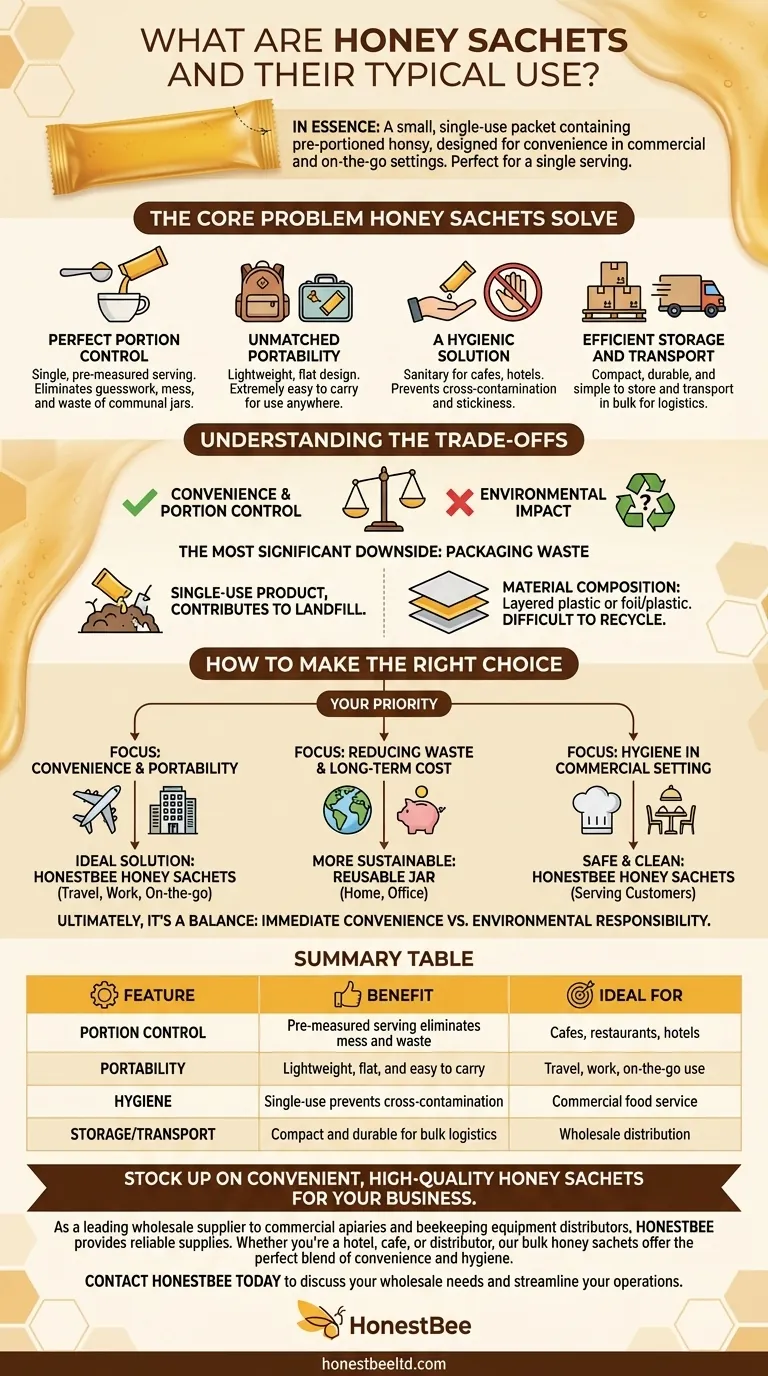In essence, a honey sachet is a small, single-use packet containing a pre-portioned amount of honey. They are specifically designed for convenience in commercial settings like hotels and cafes or for personal, on-the-go consumption. Their purpose is to provide just enough honey for a single serving, such as for sweetening a cup of tea or coffee.
The core value of honey sachets lies in their unparalleled convenience and portion control, but this comes at the direct cost of increased packaging waste compared to traditional jars.

The Core Problem Honey Sachets Solve
Honey sachets address the challenges of portability, hygiene, and waste that can arise from using honey from a larger container, especially in public or travel settings.
Perfect Portion Control
Each sachet contains a single, pre-measured serving. This eliminates guesswork for the consumer and prevents the mess and waste associated with scooping honey from a communal jar.
Unmatched Portability
The sachets are made from lightweight materials like plastic or foil. Their small, flat design makes them extremely easy to carry in a bag, pocket, or lunchbox for use anywhere.
A Hygienic Solution
For businesses like cafes, restaurants, and hotels, sachets provide a sanitary way to offer honey to many customers. They prevent the cross-contamination and stickiness that are common with shared honey dispensers or jars.
Efficient Storage and Transport
From a business logistics perspective, sachets are simple to store and transport in bulk. They are compact and durable, which is a significant advantage for the hospitality and food service industries.
Understanding the Trade-offs
While sachets offer clear benefits in convenience, their primary drawback is environmental. This is a critical factor to consider in their use.
The Environmental Impact
The most significant downside is packaging waste. As a single-use product, each sachet is typically disposed of immediately after use, contributing to landfill waste.
Material Composition
Sachets are usually made from layered plastic or a combination of foil and plastic. These materials are chosen to protect the honey from moisture and air but are often difficult to recycle.
How to Make the Right Choice
Your decision to use a honey sachet or a traditional jar should be based on your specific priority for the situation.
- If your primary focus is convenience and portability: Honey sachets are the ideal solution for travel, work, or any on-the-go use.
- If your primary focus is reducing waste and long-term cost: A reusable jar of honey is the far more sustainable and economical choice for home or office use.
- If your primary focus is hygiene in a commercial setting: Sachets provide a safe, clean, and mess-free option for serving customers.
Ultimately, the choice between a sachet and a jar is a conscious decision that balances immediate convenience against environmental responsibility.
Summary Table:
| Feature | Benefit | Ideal For |
|---|---|---|
| Portion Control | Pre-measured serving eliminates mess and waste | Cafes, restaurants, hotels |
| Portability | Lightweight, flat, and easy to carry | Travel, work, on-the-go use |
| Hygiene | Single-use prevents cross-contamination | Commercial food service |
| Storage/Transport | Compact and durable for bulk logistics | Wholesale distribution |
Stock up on convenient, high-quality honey sachets for your business.
As a leading wholesale supplier to commercial apiaries and beekeeping equipment distributors, HONESTBEE provides the reliable supplies you need to meet customer demand. Whether you're a hotel, cafe, or distributor, our bulk honey sachets offer the perfect blend of convenience and hygiene.
Contact HONESTBEE today to discuss your wholesale needs and streamline your operations.
Visual Guide

Related Products
- Premium Diamond-Faceted Glass Honey Dispenser
- Inverted Squeezable Honey Jar with No Drip Flip Top Cap for Easy Pouring
- Classic Drum Shaped Glass Honey Jar with Airtight Lid
- Premium Heat-Resistant Glass Honey Dipper
- Natural Wood Honey Dipper for Tea Coffee and Desserts
People Also Ask
- What is a honey taking spoon called? Discover the Tool for a Perfect, Mess-Free Drizzle
- How do you adjust the flow of honey using a honey gate valve? Master Precision Control for Your Bottling Line
- Why use a honey drizzler? Achieve Perfect, Mess-Free Drizzling Every Time
- What is a honey dipper and what is it used for? A Guide to Mess-Free Drizzling
- Can we store honey in a stainless steel container? Yes, with the right food-grade choice.



















